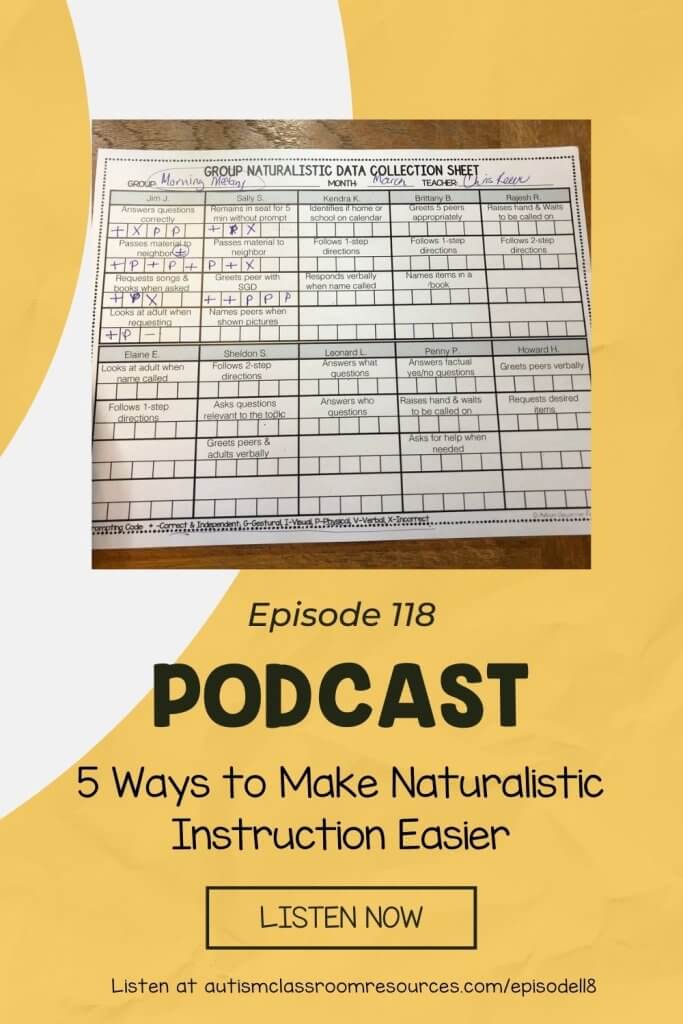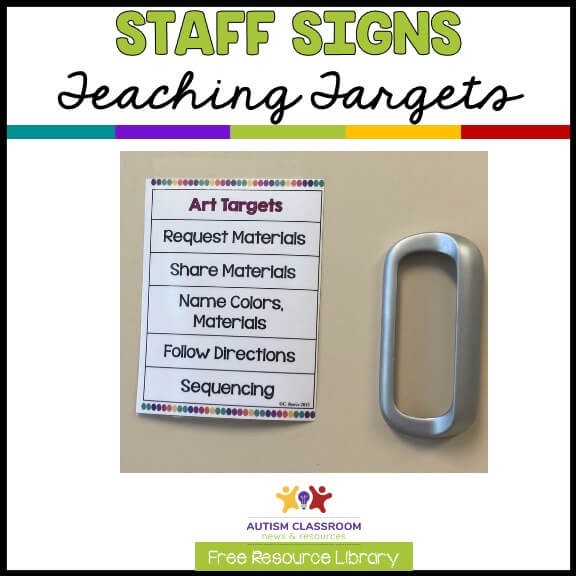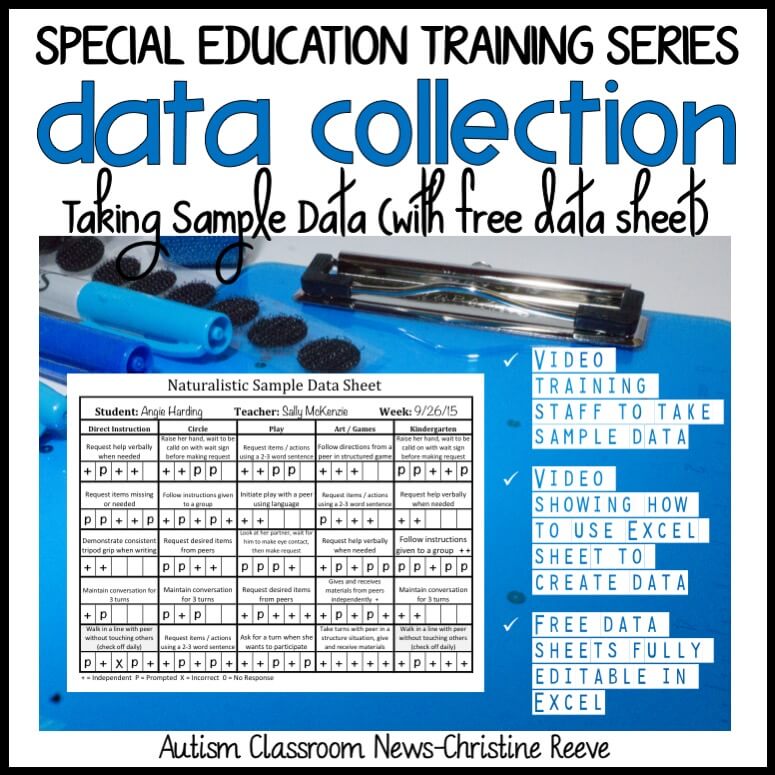Welcome to the Autism Classroom Resources Podcast, the podcast for special educators who are looking for personal and professional development.
Christine Reeve: I’m your host, Dr.Christine Reeve. For more than 20 years, I’ve worn lots of hats in special education but my real love is helping special educators like you. This podcast will give you tips and ways to implement research-based practices in a practical way in your classroom to make your job easier and more effective.
Welcome back to the Autism Classroom Resources Podcast. Hello, I am Christine Reeve. I’m your host. This month, we are talking all about ABA Instructional Strategies. I know there’s a lot of discretion out there about ABA, what it is, and what it means for individuals on the spectrum. There’s some highly emotional views about its use. I talked about all of that last week as much as you can actually in a podcast episode. If you want to know any more about that or an understanding of my views on that, check out Episode 112 at autismclassroomresources.com/episode112.
There is so much to talk about with ABA instruction that I could talk about it forever. I’ve tried to pick elements that I think are important to how we can use it effectively in the classroom because I’m only going to talk about it for a month and I’ll be back talking about it in the future. I’ll take you to other references and resources I have about it as well. In today’s episode, I’m going to talk about Naturalistic Instruction Strategies. I’ll talk about what they are. I’ll talk about why and how they’re a little bit more complex to try to implement in a classroom environment and make sure that we’re getting the intensity of them that we need. But don’t worry, I also have three strategies that can help you make it easier so that you can use naturalistic instruction in your classroom and still get a big impact for your students.
Now, let me pause by reiterating something that I said last week. One of the elements of ABA, and really, any good instruction that is something that I think is critical is that there is no one-size-fits-all intervention. Typically, we also don’t use just one kind of intervention. Some skills lend themselves to one type of instruction like discrete trials, while others lend themselves better to naturalistic instruction like communication skills. Always keep that in mind when I’m talking about all of them. I’ll touch on some of those decisions a little bit today as well.
In addition to all of this, I’ve got a free tool for you today to download to help with implementing naturalistic instruction in the classroom. I’ll talk more about that during the episode. If you’re looking for tips and tools to help make your classroom work go smoother and more efficiently, come, check out the Special Educator Academy. We have tons of tools and tips to help you help your students. We have workshops, trainings, tips, templates all designed to help you work and plan as efficiently as possible. Grab your seven-day free trial at specialeducatoracademy.com. Now, let’s get started.
Let me start with what is naturalistic instruction. What I’m going to classify as naturalistic instruction are a collection of strategies focused on arranging the environment to elicit a skill, sabotaging or situational sabotage of the environment, which is another environmental arrangement, setting up routines in the natural setting, scheduling routine, scheduling a skill, all of which are happening in the area and the situation in which that skill would generally be used. It is primarily a child-directed strategy.
Just to give you an understanding of that, child-directed means we’re going to follow the student’s lead. Discrete trials, for example, or a lot of our reading instruction, is a teacher-directed instruction. The teacher gives a direction and the student follows it. We tell a student to match and they match. We tell them to read a word and they read it. I’m deciding what we’re doing. I’m making the decision about what the skill is, what the materials are.
In a child-directed strategy, we are following the child’s lead. What are they expressing interest in, what are they picking out from their environment or that we’re presenting to them and we’re building our skills around that. It’s a lot more teaching on the fly. It’s not as easy as teacher-directed instruction in my opinion because we can’t plan it all out ahead of time because we’re giving the child the opportunity to make choices and participate in that decision making. That means that we have to be able to think about our instruction as we go and that does make it a little bit harder.
It includes incidental teaching, Pivotal Response Training, embedded teaching, Natural Environment Training, or NET training that you may have heard that’s often talked about with verbal behavior. It could also include some of the strategies like communication temptations from Barry Prizant that’s used by a lot of SLPs. Any kind of strategy that’s being set up in the natural environment with a consistent systematic instructional strategy would be considered a naturalistic intervention.
The principles of naturalistic intervention are that we’re following the child’s lead, we’re watching for what motivates them, we’re using everyday materials that they’re going to use in that situation so we’re not making up materials that we’re not using at other times. We’re teaching it in the context where they need to use the skills that we’re teaching greeting people when we come in the door, not in the middle of the day because we happen to be in an activity where I can say, “Greet this person.” We’re using naturally occurring stimuli or naturally occurring directions, which is I see a new student whom I haven’t seen today and I say, “Hello,” as opposed to the teacher saying, “Say hello to such and such.” That’s not generally how I greet people in the morning.
We provide naturally occurring consequences. I ask for something to eat and I get something to eat. I ask to go outside and I get to go outside. I ask for my favorite toy, I get my favorite toy. I don’t ask to go outside and get a cookie for good talking. The teaching sessions are pretty loosely structured and they’re going to vary obviously because of it being based around the students’ interest. Those are really just examples. Let me give you an example of incidental teaching just to give you an idea of a naturalistic strategy.
In incidental teaching, we are specifically sabotaging the environment. I know that word sounds bad but essentially, all it means is I’m setting up a situation on purpose. The teacher puts one of Jimmy’s favorite foods in a container that he can’t open. Then she shows it to him and she waits for him to respond in some way. She’s waiting for him to ask for help. She’s waiting for him to hold it out to her. She’s waiting for him to do something to give her a sign that he’s going to communicate to get some assistance. When he takes it and he can’t get it open, maybe she prompts him by putting her hand out to give it to her to ask for help. She’s encouraging a response. When he hands it to her, she says, “Help” as a model for him. Then she opens it and gives it to him. He still gets that desired item. He’s being reinforced by the thing that he wanted and he’s getting a model of what the behavior is that she wants to see more of. Over time, she’ll change what she’s reinforcing to get him closer and closer to the behavior she wants to see.
Now, there are varying arrangements of those and I’ll put some links to some posts I have on some different strategies like PRT and incidental teaching that go through those in more detail. But if I spend any more time on that, that’s all we’re going to talk about today and that’s not all I want to talk about today. To summarize for all the naturalistic interventions in general, they tend to have better—and by better, I mean faster and less extra instruction—better generalization than teacher-led instruction, which would be like discrete trials. That’s because we’re teaching the skill in the setting that they’re going to use it. It may take them longer to master the skill because we’re using a looser kind of protocol. We aren’t isolating the instruction to screen out distractions. That’s why it sometimes takes longer for the students to master the skills because it’s harder for them to know what to focus on.
One of the other things that’s tough about naturalistic instruction in a classroom environment is being able to get enough repetition of the skill to master it efficiently. When you’re doing a teacher-led instruction, you’re in charge of how many trials or opportunities you’re presenting. Typically, you should base those on your students behavior and their responses but you have more control on how many times you’re going to repeat and practice that skill. But in naturalistic interventions, you don’t have as much control over that because it’s all child-led. That means that the child loses interest in a material you have to pivot your response to a different skill or activity. Because you’re teaching it in a naturalistic way, it also means that just repeating the same skill over and over isn’t going to make sense the way it might in a discrete trial format.
Think about it this way. If you are teaching a student to read a word or read a sentence, you might have him repeat the word several times to practice reading it. Then you might repeat it in different sentences. Getting five or more opportunities to practice that skill in one session is pretty easy. But if we’re teaching something in a naturalistic environment, we’re waiting for that word to show up in a text as part of our story. We would be reading other words at the same time, not just repeating the same word. Getting the number of opportunities for practice into the situation is harder to do.
Another example might be greetings. We typically teach greetings in the classroom during morning meetings or when students enter or leave the classroom, but if we just say hi to one student at one time during the day, that’s probably not enough repetition for most of our students to learn it effectively. Instead, we want to target saying hi to four or five people in the classroom during that time so that they practice it multiple times. Now, for that to be child-led, I’m going to have to give them maybe something that the kid likes so that he wants to talk to them. I’m going to have to set it up in the classroom ahead of time.
Given that naturalistic instruction is a little tougher to do in a classroom environment, this is the part I really wanted to get to today which are some tips to boost the opportunities to get those numbers of repetitions up and make sure that everybody in the class knows how to fold those opportunities into the natural environment. Because it is more teaching on the fly, it does require a little bit more work to make sure that it’s going to happen.
First, staff need to know that when you tell them to target a skill in cooking or art morning meeting, it doesn’t mean to just do it once. They need to know that it needs to be repeated and they need to know how to create those opportunities for the student to practice by changing the environment. Training staff is obviously a really important component here. I’ve got an episode with resources for training the staff available that you can grab. You can go to autismclassroomresources.com/episode23 for that. I’ll make sure that that goes into the show notes as well.
The second thing is that your lesson plan is going to be a critical element to everyone in the classroom. As the teacher, you develop it knowing your students’ IEPs and the curriculum so that you have planned out when the specific skills and targets can be taught. You’ve already thought ahead to where this makes sense. The TIP or the Teaching Implementation Plan plays a role in that as well. It’s something I’ve talked about in the past. I will link to some information about that as well. The staff needs to know what needs to be done and taught in each activity. I make sure that all of that information goes into the Staff Zoning Plan. The zoning plan is essentially a super power schedule for staff. I’ve written about zoning plans frequently and you can learn more about them. You can download a free set of samples at autismclassroomresources.com/episode45. That will be in the show notes as well.
The zoning plan has everything in it that staff needs to do during that time that wouldn’t be on the lesson plan. It lets them know which students they need to be facilitating during each activity which then tells them that they need to look at the lesson plan or the data sheet, which I’ll talk about in a minute, to determine what they need to focus their support on. That means that the instruction actually gets implemented in your classroom.
The next element that helps staff know what skills to target, and when, are data sheets. I use a group data sheet for a lot of the naturalistic instruction. Naturalistic instruction tends to occur in group activities, so group data sheets that I sometimes call a naturalistic data sheet—if that’s the one I use for one student or multiple students—is designed to take a weekly sample of the student’s performance on specific skills. However, the skill is taught every single day. We’re taking a weekly sample of the data but we’re still teaching it every day. The data sheet has five boxes for opportunities. I use that as a reminder for staff to get at least five opportunities for the student to make that request, name that item, comment on something, or ask a question, etc. It serves as the checks and balances for the teacher because if you see that the students aren’t getting any more than one opportunity on the data sheet, that means that it’s time for a little bit more training on how to create those multiple opportunities. You can grab a tutorial and the group/naturalistic data sheet for free in my TpT store. I’ll make sure that link is in the show notes as well.
That brings us to the last item and the free download that I actually intended for this episode. I develop visual cues for the staff and I post them in activity areas with reminders of the common targets to work on during that time of day. During arrival/departure, I might have respond to greetings, initiate greetings, independence in arrival routines, signing in, and independence with fasteners. This then gets posted by the door or by the student’s cubbies where everybody is reminded to work on those skills. I have some target cards for you. They go with my visual reminders for Special Ed Staff Product on TpT. You can download the target cards for free with this episode. I’ll make sure that link is in the show notes.
In the product, I have editable versions that you can actually change and individualize. You could have one for Sami and Ruth, and for each student. The ones that I’m going to give you are common ones that you see that are already made for you. You can grab those at autismclassroomresources.com/episode113. I hope that gives you some ideas of ways to integrate natural instruction into your day. Naturalistic instruction is natural—I’m sorry I couldn’t resist that—for communication and social skills but it also is sometimes helpful for academic skills as well. There are some students who learn best with naturalistic instruction instead of teacher-led instruction. It’s definitely a worthwhile tool to have in your toolbox.
If you’re looking at expanding your toolbox of teaching strategies to meet the needs of your diverse learners, definitely come out and check out the Special Educator Academy. We have tons of resources and training on naturalistic instruction as well as many other evidence-based practices for students with autism and for students with all different types of disabilities. Grab your seven-day free trial at specialeducatoracademy.com. I want to thank you so much for joining me today. I hope that you’ll come back next week for another episode about ABA Instructional Strategies. Until then, have an amazing and wonderful week.









